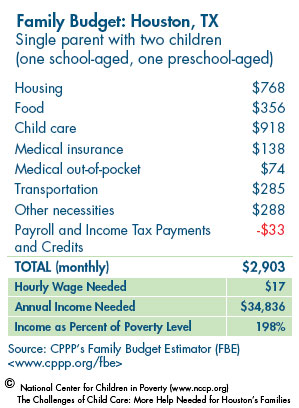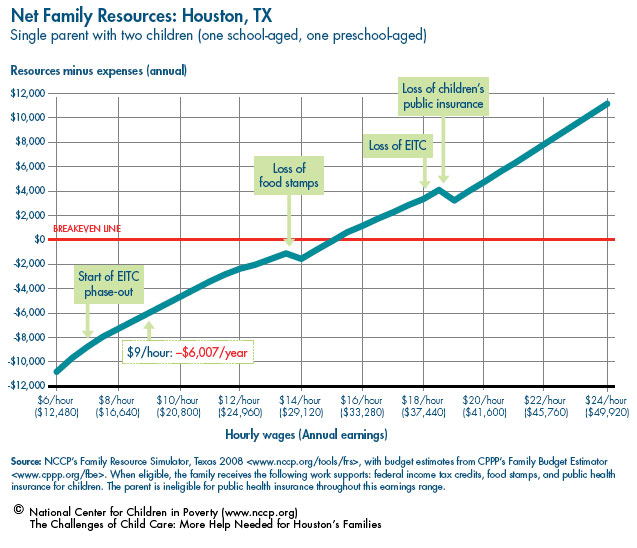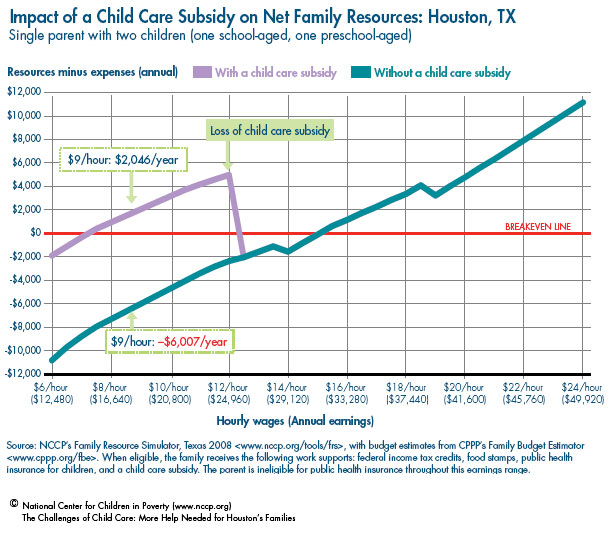Learn about our Making Work Supports Work project.
Houston families are working harder than ever. In fact, more than 75 percent of the children living in low-income families in Houston have parents who are employed, and the majority of these children – about 400,000 – have parents who work full-time, year-round. But, despite their best efforts, these parents are struggling to afford the most basic necessities for their families. In Houston, as elsewhere in Texas and the United States, a full-time job at low wages is not enough to make ends meet.
Work supports such as the federal Earned Income Tax Credit (EITC) and public health insurance can help narrow the gap between low earnings and the cost of basic expenses. But a critical Texas work support – child care assistance – is woefully underfunded and therefore out of reach for many qualified families. This fact sheet finds that child care is one of the largest expenses working families face, and unless they receive help with the cost of care, low-wage working parents remain unable to afford basic family necessities.
Findings are based on results from NCCP’s Family Resource Simulator, using budget estimates from the Center for Public Policy Priorities’ Family Budget Estimator.
The Family Resource Simulator is an innovative policy analysis tool that shows the impact of federal and state work supports on the budgets of low- to moderate-income families. Simulators are currently available, or under development, for 20 states, including more than 100 localities. The Texas Simulator includes seven localities – Austin, Dallas, El Paso, Houston, Laredo, Lubbock, and San Antonio – and reflects policy rules in effect as of April 2008.
The Family Budget Estimator uses a “market-basket” approach to determine how much income working families require to meet their basic needs. It provides budgets for eight family types across 27 metropolitan areas in Texas.
A Low-Wage Job Can’t Cover Cost of Child Care and Other Basic Expenses

A single parent living in Houston with two children, one preschool-aged and one school-aged, needs an annual income of about $35,000 just to afford minimum daily necessities (see Figure 1). That’s the equivalent of working full-time, year-round at $17 an hour, well more than twice the minimum wage of $6.55. Moreover, $35,000 covers only a bare-bones budget with no room for an occasional meal out, never mind saving for the future. It also assumes families have access to employer-sponsored health insurance, though the majority of low-income workers lack such coverage.
The family’s largest single expense – larger even than the cost of housing – is the cost of child care. Reliable care is critical for working parents, and high quality care is important for children’s development. For low-income children, it can help bridge the achievement gap between them and their more affluent peers. But the high cost puts reliable, quality care out of reach for many of the families who need it most.
Available Work Supports Aren’t Enough
Federal and state work supports can help low-wage workers provide for their families. But for many in San Antonio, available supports fail to close the gap between earnings and the cost of basic needs. Assuming receipt of the federal EITC and other income tax credits, food stamps, and public health insurance, Figure 2 shows how net family resources – that is, resources after subtracting the cost of basic expenses – change as family earnings increase. As in Figure 1, results are based on a single parent with two children and a full-time job.

Even with multiple benefits, this family is unable to consistently make ends meet until wages reach just over $15 an hour, assuming the parent works full-time, year-round. That’s higher than the hourly wages of the majority of Houston workers.
- With a full-time job paying $9 an hour, the family faces a gap of close to $6,000 between annual resources and expenses.
- The federal EITC begins phasing out long before the family is able to afford basic necessities.
- At $14 an hour, the family loses food stamp benefits. This loss occurs before they reach the “breakeven” point – that is, the point where the family’s resources, including earnings and benefits, equal the family’s basic expenses.
Moreover, while the children are eligible for public health insurance until the parent’s wages reach $19 an hour, the parent is ineligible for coverage for herself even when earning the minimum wage. Without employer-sponsored insurance, the parent would likely be uninsured as she would be unable to afford coverage on the open market.
Child Care Assistance is Critical, But Access is Limited
While work supports can help address the gap between resources and expenses, many families do not receive the benefits for which they are eligible. For families in Houston and other areas of the state, child care assistance is particularly difficult to access as limited funding has led to long waiting lists for assistance. As of December 2007, applicants for child care subsidies in Houston were placed on a waiting list of more than 8,000 children.

For those families who do receive a child care subsidy, this assistance can make a tremendous difference. Texas’ child care subsidy program covers a substantial portion of the cost of care, with families paying a copayment that rises with income. Continuing with the same family from above, Figure 3 shows that with a child care subsidy, other work supports, and a full-time job paying $9 an hour, a single parent with two children could make ends meet. The family would have a small annual surplus of about $2,000 after covering basic daily needs, money that could be used to pay off debt or saved for education or a home.
Unfortunately, the income eligibility limit for child care subsidies in Houston is low. In Texas, the 28 local Workforce Development Boards have the discretion to set income limits for child care subsidies up to 85 percent of state median income, or roughly $41,000 for a family of three. The income limit for the Houston area is just 150 percent of the federal poverty level – about $26,000 a year for a family of three. Figure 3 shows how Houston’s low eligibility limit for child care subsidies can make it difficult for parents to provide for their families as they advance in the workforce. In this example, when the parent’s wages rise to $12.50 an hour, the family loses child care subsidies, plunging their net resources below the breakeven line. The family is unable to make ends meet again until wages reach about $15 an hour. Moreover, even at $16 an hour, the family is still worse off financially than it was when the parent’s hourly wage was just $9. A raise that nearly doubles the family’s earnings brings them no closer to financial security.
More Support Needed to Make Work Pay
If parents work full-time, their earnings, combined with public benefits, should be sufficient to cover basic family expenses. But for many in Houston, even a full-time job plus available work supports is not enough. A key problem is limited access to child care subsidies because the U.S. Congress and the Texas Legislature have not put enough money into the program to cover the need. While subsidies are guaranteed for current and former Temporary Assistance for Needy Families (TANF) cash assistance recipients, the state’s other low-wage working families must wait for help. Moreover, the low income eligibility limit means that many working families earn too much to qualify for assistance – yet not enough to afford quality care on their own. Expanding eligibility and increasing access to child care assistance for those who are eligible would be an important step toward making work pay for all of Houston’s families.
Endnotes
The authors thank Frances Deviney and Celia Hagert of the Center for Public Policy Priorities (CPPP) for their substantial assistance, including providing budget estimates from CPPP’s Family Budget Estimator.
1. Low-income is defined as twice the federal poverty level, or $35,200 a year for family of three in 2008. Figures reflect data for the Houston metropolitan statistical area. Source: NCCP analysis based on the U.S. Current Population Survey, Annual Social and Economic Supplements, March 2006, 2007, and 2008.
2. This example assumes that family members have employer-sponsored health insurance; the impact of sales and property taxes is conservatively captured in housing and other basic necessities values.
3. Clemans-Cope, Lisa; Garrett, Bowen; Hoffman, Catherine. 2006. Changes in Employees’ Health Insurance Coverage, 2001-2005. Washington, DC: Kaiser Commission on Medicaid and the Uninsured, Henry J. Kaiser Family Foundation.
4. The Center for Public Policy Priorities estimates the cost of care based on data for home and center-based care from the 2005 Texas Child Care Market Rate Survey, assuming that the family has one preschool-aged child and one school-aged child (with the older child in part-time care during the school year). For more details, see <www.cppp.org/fbe/methodology.pdf>.
5. Votrbua-Drzal, Elizabeth; Coley Levine, Rebekah; Chase-Lansdale, Lindsay P. 2004. Child Care and Low-Income Children’s Development: Direct and Moderated Effects. Child Development 75 (1): 296-312.
6. U.S. Department of Labor, Bureau of Labor Statistics. 2007. May 2007 Metropolitan and Nonmetropolitan Area Occupational Employment and Wage Estimates: Houston, TX (accessed Aug. 28, 2008).
7. By taking advantage of a federal option to expand categorical eligibility for food stamps, Texas has effectively raised the gross income limit for food stamps from 130 percent of the federal poverty level to 165 percent for most households. These results reflect this policy; without it, the family would lose food stamps at a lower earnings level and the benefit “cliff” would be significantly larger.
8. This waitlist was for the 12 counties served by the Gulf Coast Workforce Development Board. Source: Personal communication from Lona Chastain, Texas Workforce Commission, to the Center for Public Policy Priorities, June 18, 2008.
9. Houston provides extended child care assistance for up to 12 months to existing subsidy recipients whose income rises above the basic eligibility limit of 150 percent of poverty ($26,400 a year for a family of three) but remains below 75% SMI ($42,222 a year for a family of three).
